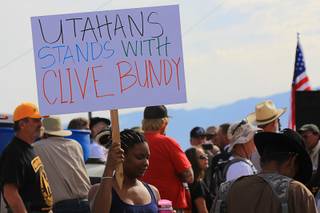
Shannon Bushman
Bureau of Land Management law enforcement rangers take up a position during the April 12, 2014 stand-off between the BLM and supporters of rancher Cliven Bundy near Bunkerville, Nevada. The BLM eventually called off their roundup of Bundy cattle citing safety concerns. Courtesy of Shannon Bushman.
Published Wednesday, April 12, 2017 | 10:17 a.m.
Updated Wednesday, April 12, 2017 | 8:10 p.m.
A jury in Las Vegas was asked Wednesday to decide if gunmen who brought assault-style rifles to a 2014 protest near Nevada cattleman Cliven Bundy's ranch prevented violence against unarmed protesters during a tense standoff or committed armed acts of violence against federal agents.
Defense attorneys representing two Idaho men among the six defendants standing trial for forcing the government to end a round-up of cattle from public land told the U.S. District Court jury their clients committed no crimes.
Defendant Steven Stewart exercised his First Amendment right to free speech by using his Second Amendment right to have firearms, defense lawyer Richard Tanasi said.
"This is a case of standing up for what you believe in," the attorney said. "A protest is not a conspiracy."
Earlier, prosecutor Nicholas Dickinson told jurors that even though no shots were fired, federal agents were the victims of crimes of violence by gunmen supporting a Bundy conspiracy to free his cattle exactly three years ago.
The agents were assaulted, threatened and impeded from carrying out U.S. District Court orders to impound Bundy cattle, Dickinson said.
"You can't just go vigilante and resist law enforcement officers," he said. "You especially cannot do it with guns."
Defendant Eric Parker's lawyer told jurors that Parker decided to go to a place he'd never been to help people he'd never met because he was incensed by internet reports that Bundy family members had been arrested and injured during earlier confrontations with U.S. Bureau of Land Management agents using dogs and stun guns.
"Some people protest with signs. Other people protest with guns," attorney Jess Marchese said. "At the end of the day, no one was hurt, and that's the important thing."
The trial represents the latest skirmish in a long-running dispute over land policy in the U.S., where states' rights advocates in the West want to wrest federal control of vast tracts of public land in states including Nevada, Utah, Idaho and Oregon.
After more than a day of closing arguments, the federal jury could begin deciding questions of guilt and innocence on Thursday.
Deliberations are expected to take time. Chief District Judge Gloria Navarro spent 45 minutes just reading aloud the instructions the jury will rely on to weigh two months of testimony and reach verdicts on 10 charges including weapon violations, conspiracy, obstruction, extortion and threatening and assaulting a federal agent.
"These six ... use, carry, brandish and even point their weapons at federal law enforcement officers," Dickinson said as he summarized the case against defendants Gregory Burleson, Scott Drexler, Todd Engel, Richard Lovelien, Parker and Stewart.
Prosecutors have photos of the men with assault-style rifles at the standoff site outside the small town of Bunkerville.
"They were clearly coming to show force," the prosecutor said, "not with signs, but with guns."
The tense noontime standoff pitted about 30 armed federal Bureau of Land Management and National Park Service officers in battle gear against more than 100 Bundy backers in a dry river bed below an arching Interstate 15 overpass about 80 miles northeast of Las Vegas.
Parker and Stewart were on the bridge, with a commanding view of the scene — flag-waving riders on horseback amid unarmed men, women and children in a crowd demanding the release of cows that had been rounded up.
Parker was photographed prone on the pavement, looking with his AK-47 style rifle through a seam in a concrete barrier toward the federal agents below.
The agents insisted the protesters should disperse. But Dickinson noted they decided not to deploy pepper spray for fear the sound would spark a bloody gunbattle.
In the end, no shots were fired, the sheriff brokered a truce, and the cows were released. Dickinson said that was the Bundy plan.
A second federal trial could start June 5 for Cliven Bundy, his sons Ammon and Ryan Bundy, and two other defendants characterized by prosecutors as leaders of the conspiracy. Trial for another six defendants would follow in the fall.

